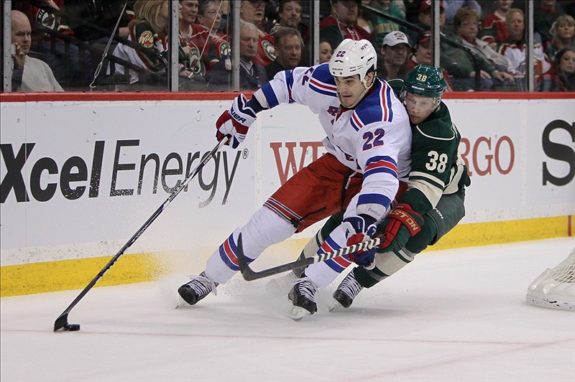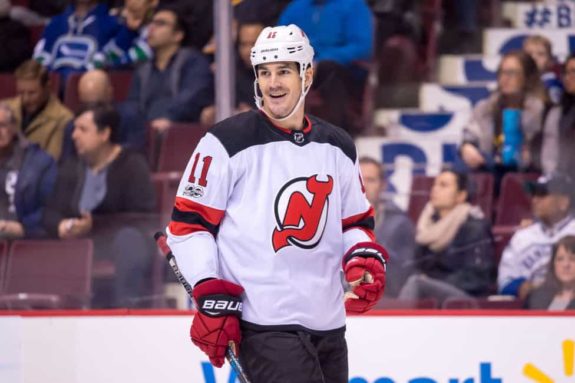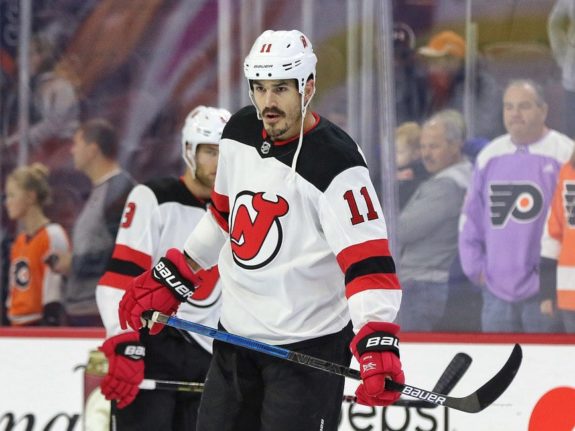On the afternoon of Feb. 6, the Nashville Predators announced they had acquired Brian Boyle from the New Jersey Devils for a 2019 second-round pick. In an effort to add center depth and toughness, Predators general manager David Poile acquired the 34-year-old veteran for a single asset, and didn’t give up a first-round pick or prospect in the process.
The #Preds have acquired forward Brian Boyle from the New Jersey Devils in exchange for a second-round pick in the 2019 NHL Draft >> https://t.co/gvfjrMQKxc
— Nashville Preds PR (@PredsPR) February 6, 2019
Considering that Boyle is a pending free agent at season’s end, this trade is likely a playoff rental, and with that comes almost no risk. What’s interesting, and positive for the Predators, is that they weren’t on Boyle’s eight-team no-trade list that is included in his contract. All-in-all, this trade is ideal for the Predators, a team looking to make a deep playoff run this spring, and I plan on talking about why it’s ideal throughout the article. But first, some back story on Boyle.
Boyle’s Career Before Trade
Although Boyle has been a bottom-six forward in his NHL career, the Los Angeles Kings drafted him in the first round (26th overall) in the 2003 Draft. They drafted him from St. Sebastian’s, a high school in his native Massachusetts for whom he had 32 goals and 63 points in 31 games his senior season.
He followed that up with four seasons at Boston College, including a season as their captain in his final season. He finished his collegiate career with 65 goals and 140 points in 159 games and was a two-time Hockey East champion, a one-time first-team and one-time second-team All-American.
He turned pro at the end of the 2006-07 season and joined the Kings’ AHL affiliate, the Manchester Monarchs. In 16 Calder Cup Playoff games, he had three goals and eight points. He mostly played in the AHL the next two seasons and made his NHL debut on Feb. 2, 2008 against the Devils and registered the first two points of his career in that game, including his first goal. The Kings dealt him to the New York Rangers on June 27, 2009 for a 2010 third-round pick that resulted in Jordan Weal.

Boyle spent five seasons with the Rangers and had 44 goals and 90 points in 355 regular-season games. He helped the Rangers reach the postseason in his final four seasons in New York with nine goals and 19 points in 58 postseason games. On July 1, 2014, he signed a three-year, $6 million deal with the Tampa Bay Lightning and served as their alternate captain every season. In 212 regular-season games with them, he had 41 goals and 66 points. The Lightning qualified for the postseason his first two seasons in Tampa, and he had six goals and an assist in 42 playoff games.
They traded him to the Toronto Maple Leafs on Feb. 27, 2017 for Byron Froese and a 2017 second-round pick that the Lightning used on Alexander Volkov. Boyle played in 21 games with Toronto and finished with three points, all assists. They reached the postseason and he played in six games with them in the 2017 Playoffs and compiled two assists. On July 1, 2017, he signed two-year deal with the Devils that carries a $2.55 million cap hit.
Before he played a game with New Jersey, he was diagnosed with chronic myeloid leukemia, a form of cancer, and returned to the ice on Nov. 1. Just over 12 months after his diagnosis he learned his cancer had gone into remission. He appeared at the 2018 All-Star Game as the Devils’ representative after Taylor Hall went down with injury.
However, it wasn’t all positive, as he and his wife learned that their two-year-old son, Declan, had been diagnosed with an aggressive form of cancer that manifested itself in a jaw deformation. As a result of his off-ice struggles, Boyle was awarded the 2018 Masterton Trophy for perseverance and sportsmanship.
In total, he appeared in 116 regular-season games with New Jersey and scored 13 goals and 23 points. He also helped them reach the 2018 Playoffs and went pointless in five games. In 2018-19, he has 13 goals and 19 points in 47 games. That brings us to the present and the trade that sent him to Nashville.
His Impact on Linemates
As a veteran who plays on the fourth line, how Boyle affects his linemates will be important to his success on the Predators’ fourth line. He will presumably play with some combination of Frédérick Gaudreau, Rocco Grimaldi, Colton Sissons, Mikka Salomäki and newly-acquired Cody McLeod once Kyle Turris returns.
With the Devils in 2018-19, Boyle played the most with Brett Seney and Drew Stafford. In 81 shared five-on-five minutes, the line had the following metrics: 38.4 shots for percentage (SF%), 50.0 goals for percentage (GF%), 37.5 scoring chances for percentage (SCF%) and 42.9 high-danger chances for percentage (HDCF%). Those occurred while starting in the defensive zone 37.2 percent of the time. Devils netminders had a .911 save percentage (SV%) when the line was deployed.
Without Boyle, Seney and Stafford’s metrics were: 38.8 SF%, 0.0 GF%, 38.9 SCF% and 46.7 HDCF% while the goaltenders had a .921 SV%. While those metrics don’t show Boyle’s positive impact, the reality is that Seney and Stafford weren’t starting in the defensive zone as often without Boyle, and that when Boyle and Stafford played together without Seney, their metrics jumped. This indicates that Seney was the issue.

In 2017-18, Boyle played the most with Miles Wood and Stafford with 61 shared five-on-five minutes and the line started in the defensive zone 47.6 percent. Their metrics were 47.0 SF%, 14.3 GF%, 46.8 SCF% and 52.8 HDCF% while goaltenders had a .903 SV%. Without Boyle, Wood and Stafford’s metrics were 55.4 SF%, 14.3 GF%, 50.8 SCF% and 58.6 HDCF% with an .818 SV%. Again, Boyle wasn’t the issue, however, as Wood was the player who dragged down the line.
Players who receive such non-advantageous zone starts while being tasked with playing a defensive role typically struggle to have positive metrics as they are at a disadvantage from the drop of the puck. With the Predators, Boyle will likely continue receiving the majority of defensive zone starts and will help out the team’s netminders.
What Can Fans Expect from Him?
There is nothing to not like about Boyle. He is a defensive center who takes on the team’s toughest assignments and usually comes out on top. He hasn’t had an offensive zone start split since 2008-09, including starting in the defensive zone 77 percent of the time in 2013-14 with the Rangers. He has somehow managed at least an even turnover margin in 11 of his 12 seasons despite those tough assignments and is a plus-two in 2018-19.
He’s strong in the faceoff dot with a 50.2 percent success rate this season and is at 50.1 percent for his career. He plays a lot on the penalty kill and is averaging 1:57 of shorthanded time per game this season, which would be the third-highest average among Predators forwards behind Sissons and Nick Bonino. Boyle even has a shorthanded goal and assist this season.

He has also played a lot on the power play this season with a 2:53 per-game average that would be fourth-highest among Predators forwards. He has converted that ice time into six power play goals and two power play assists and his six goals would be tops among Predators. Boyle enjoys playing on the man advantage, especially when it comes to creating screens, deflecting shots and scoring on rebounds, all aspects the Predators have struggled with this season.
Then there’s his size. At 6-foot-6 and 245 pounds, Boyle will be the tallest and heaviest skater on the Predators roster by two inches and 27 pounds. Size is something the Predators have lacked this season and he addresses that need. He’s also a left shot, something the team was short on among forwards as nine of their 12 regular forwards were right shots before this deal.
Related: Predators’ Trade Deadline Strategies
Lastly, there’s his personality and locker-room presence. He went to New Jersey and immediately helped mentor not only the team’s young players but also Hall who had never experienced the playoffs before last season. He will help solidify the leadership group in Nashville and will be a welcomed presence come playoff time when his grinding, heavy style play up. At its roots, this trade was an excellent move by Poile to acquire a quality player in Boyle who’s an even better person off the ice.
*All stats from Hockey-Reference, Natural Stat Trick and Corsica Hockey